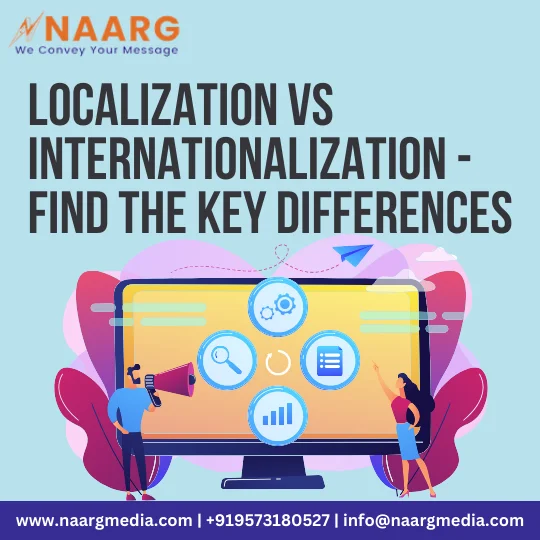When it comes to software development, localization, and internationalization are like two peas in a pod. But there are times when they are used interchangeably; in reality, they refer to different processes. Internationalization, often abbreviated as i18n, refers to the process of adapting, designing, and developing software in a way that makes it easy to adapt to multiple languages and cultures without fundamentally changing the source code.
Localization, on the other hand, often abbreviated as l19n, refers to the process of adapting and customizing a product or service for a specific locale or target market. But the question here arises: which one is better? Localization vs. internationalization. Which one should I choose? And why is the question here in the first place of localization vs. internationalization?
Want to learn more about localization vs. internationalization? And what are the key differences? Don’t worry, we have got you covered. In this blog post, we will take a closer look at the differences between localization and internationalization. Elucidating their respective purposes, components, and common similarities between internationalization and localization.

Role of Localization
Did you know that, in one study, it was revealed that localized copy increases the click-through rates of ads by 22% among women and 87% among men? When it comes to understanding the role of localization, it is paramount to ensure that your products resonate with your users across diverse linguistic and cultural landscapes. As you must be aware, localization goes beyond mere translation and involves adapting every aspect of your product to suit the unique preferences, conventions, and customs of a specific locale or target market.
This process includes not only linguistic elements like text translation but also cultural nuances like symbols, graphics, color, and even user interface design. When you tailor these elements according to the preferences and expectations of your target audience in different regions, it will enhance user engagement and foster brand loyalty. And ultimately drives the success of your product in the global market.
Moreover, effective localization demonstrates a commitment to inclusivity and respect for cultural diversity, fostering deeper connections between your users and the products they use.
Key Components of Localization
To ensure your product is effectively adapted, the localization process involves several key components for a specific locale or target market. Some of these components include:
1. Translation
The translation process is the primary component of the localization process. It involves converting texts, labels, menus, and other linguistic elements of the products into the languages or multiple languages spoken in the target market. And not just literal translation, but ensuring that the translated content reflects cultural nuances and idiomatic expressions.
2. Cultural Adaptation
This is an essential component where you adapt visual elements, symbols, colors, and other design aspects to align with the cultural preferences and sensitivities of the target audience. Now, this may involve replacing images and graphics that may be inappropriate or offensive in certain cultural contexts. By doing this, you ensure that the cultural references are relevant and meaningful to your target audience.
3. Date, Time, and Numeric Formats
Adjusting date, time, numeric format, and currency is essential to conform to the conventions and standards used in the target locale. This will ensure that your users can easily understand and interact with all these elements without confusion.
4. User Interface (UI) Design
Navigation and optimizing the user interface layout and functionality to accommodate linguistic differences, text expansion or contraction, and also user interaction preference in the target market. This component involves redesigning UI elements to accommodate longer text strings or adjusting the layout to accommodate right-to-left languages.
With these key components for your localization process, you can create products that will resonate with your users in different regions who use multiple languages to communicate. And ultimately, it will bring success to your product in global markets.
Role of Internationalization
Internationalization in software development is foundational in creating products that can effectively adapt to diverse linguistic, cultural, and regional requirements without significant source code changes. Incorporating the internationalization process from the outset of the development process lays the groundwork for making your software accessible and adaptable to your global audience.
This internationalization process not only streamlines the localization process but also reduces development costs and time-to-market by eliminating the need for extensive source code modifications for each of your target markets. Moreover, the internationalization process demonstrates a commitment to inclusivity and cultural sensitivity, fostering a positive user experience and expanding the reach of your products to diverse audiences worldwide.
All in all, you can say that internationalization serves as the backbone of your global software development, enabling your product to transcend linguistic and cultural boundaries.
Key Components of Internationalization
Several key components are involved in the internationalization process to ensure that your software products are easily adapted for your global audiences. Some of the key components include:
1. Unicode Support
When you adopt a Unicode standard, you ensure that your software can handle and display characters from multiple languages, scripts, and writing systems. Having a Unicode system provides a standardized encoding system that allows for the representation of virtually all characters used in written languages worldwide.
2. Locale Awareness
Incorporating support for different locales is essential, as it includes language, regional formats for dates, times, numbers, currencies, and other cultural conventions. It involves designing the software to dynamically adjust its behavior based on the user’s locale preferences.
3. Text Externalization
This component separates user interface text and other localizable content from the software’s codebase. So, by externalizing text into resource files or databases, developers can facilitate easier translation and localization without modifying the underlying source code.
4. Layout and Formatting Considerations
It is essential to design user interfaces and layouts that accommodate text expansion and contractions across multiple languages. This particularly includes flexible layouts, dynamic text sizing, and ensuring that UI elements can adapt to accommodate longer or shorter text strings.
Common similarities between Localization and Internationalization
While it is true that localization and internationalization are two distinct processes serving different goals, they also share several commonalities. Some of the common similarities between localization and internationalization are listed below:
1. Global Perspective
Both these processes—localization and internalization—have one thing in common: making your product accessible and usable by people from diverse linguistic and cultural backgrounds all around the world. Both processes reflect a global perspective in software development, acknowledging the importance of catering to the needs of your international users.
2. User-Centric Approach
Both localization and internationalization processes prioritize enhancing the user experience by ensuring that the software products are tailored to the linguistic, cultural, and regional expectations of your target audience. Whether it is about adapting content for a specific locale (localization) or designing software for multiple languages and cultures (internationalization), the ultimate goal is to meet the needs and preferences of your users effectively.
3. Technical Considerations
Both internationalization and localization involve technical considerations within software development. Localization focuses more on adapting content and design elements for specific locales. Internationalization focuses on designing software architecture and user interfaces in a way that supports multiple languages and cultural conventions. However, both processes require attention to technical aspects like text encoding, string handling, and support for locale-specific formats.
Key differences between Localization and Internationalization
As mentioned above, localization and internationalization are two distinct processes, each serving different purposes and involving different activities. Listed below are some of the key differences between the two:
1. Purpose
The primary goal of localization is to customize products or services for a specific locale or target market. It involves translating text, adapting graphics, adjusting formats, and addressing cultural nuances. Internationalization aims to design and develop software in a way that makes it adaptable to multiple languages, regions, and cultures without requiring significant source code changes. Its main focus is to create a foundation that enables easy localization.
2. Scope
The internationalization process focuses on the broader aspects of software development, like designing architecture, user interfaces, and code structures to accommodate multiple languages and cultural conventions. Localization deals with the specific adaptation of content, design, and functionality for a particular locale or target market. Making changes according to the product to align with the linguistic and cultural requirements of the target audience.
3. Timing
The internationalization process occurs during the initial stages of software development. It is considered a proactive process that involves designing software with global audiences in mind. Localization typically occurs after the internationalization process and involves making specific adaptations for different locales or markets. These key differences are essential to understand for software developers to effectively plan and execute both internationalization and localization processes. Ultimately, create a product that resonates with your global audience.
Contact us today to learn more about our services.




